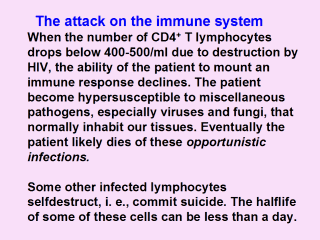| front |1 |2 |3 |4 |5 |6 |7 |8 |9 |10 |11 |12 |13 |14 |15 |16 |17 |18 |19 |20 |21 |22 |23 |24 |25 |26 |27 |28 |29 |30 |31 |32 |33 |34 |35 |36 |37 |review |
 |
Cytotoxic
lymphocyte production follows the rise of HIV in the blood. HIV specific
CD4+ T cells may be especially susceptible to attack and destruction by HIV.
HIV binds to CD-SIGN, a glycoprotein expressed in dendritic monocytes.
Migration of HIV bearing activated dendritic monocytes to helper T cell areas of lymph nodes may specifically infect helper T cells (CD4+s) that may be specific for HIV peptides. Reductions in HIV specific helper T cell numbers may lead to decreased activation and survival of CTLs (CD8+s) as well as B cells. High mutation rates common to reverse transcriptase allow HIV to escape adaptive immune responses. When the body produces appropriate antibodies against viral proteins, the virus can often mutate so that it can escape those antibodies. Then, HIV evolves by selection pressure. Again, the main problem is the destruction of CD4+ T cells. |